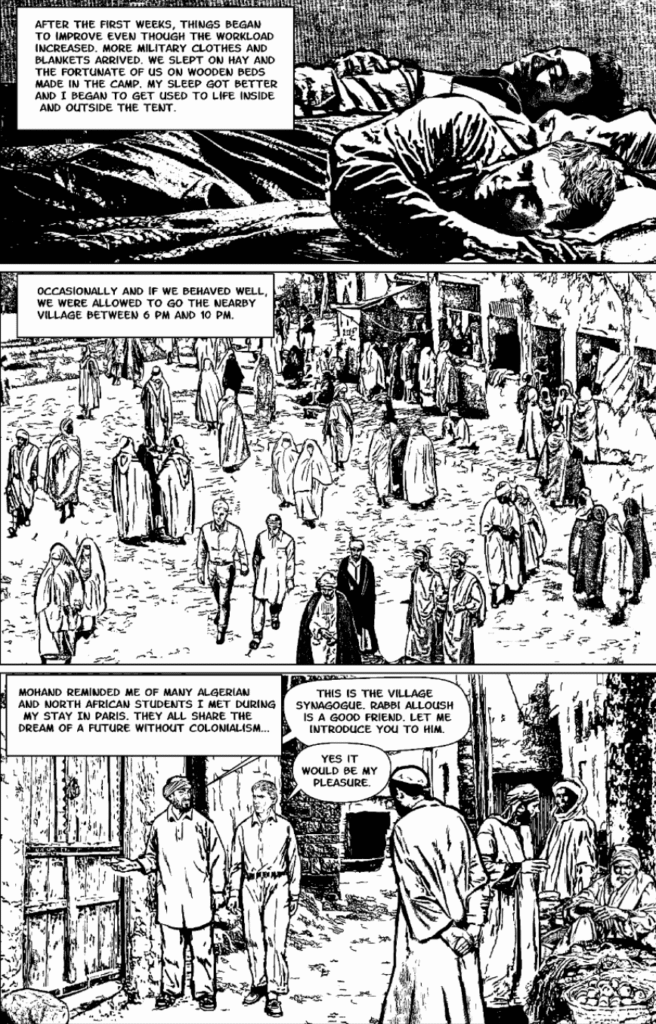
Making History Accessible: The Untold Story of Vichy ‘Undesirables’
In May 2016, Nadjib (Nad) Berber and I committed to collaborating on a graphic history that would bring to light the lesser-known historical narrative of Vichy undesirables. The Vichy undesirables were European Jewish refugees, Spanish Republicans, political dissidents, and North African nationalists interned in Vichy labor camps across the Sahara during World War II.
Nad, an Algerian comic artist and political cartoonist, and I, a Moroccan historical anthropologist, resided in Los Angeles when we embarked on the production of Undesirables: A Holocaust Journey into North Africa, an ethnographic history of the Saharan Vichy camps, a graphic novel that merges history and comics to produce a visual ethnography of the Second World War.
Our artistic-ethnographic approach hinged on reanimating archival information as if it were unfolding in front of our eyes. In the absence of cameras and live witnesses to the internment of refugees and political prisoners in the Vichy camps scattered across the Sahara, we turned to what the archive could offer. We translated this historical material into visual dialogue and scene, crafting a form of storytelling that presents ethnographic data through imagined conversations grounded in documentary evidence.
At the time, I had just completed a series of encyclopedic entries for the United States Holocaust Memorial Museum and had co-organized, with UCLA colleagues Sarah A. Stein and Todd Presner, a conference on the Holocaust and North Africa at the university’s Alan D. Leve Center for Jewish Studies. Yet, I was yearning to create a different kind of text, something easily accessible to a broader public, including high school students. The existing scholarship on this topic, while invaluable, remained largely within academic circles. I believed it was urgent to make this history available through the more widely approachable and emotionally resonant medium of comics and graphic novels.

I propose that it is possible to do an anthropology of the Holocaust through a Mediterranean-style bande dessinée (comic) that I call “retroactive ethnography.” This approach to historical ethnography is shaped above all by the archive: it reconstructs scenes from the past with a sense of immediacy and presence. Nad and I chose a comic style that draws on visual realism, designed to convey the impression of being there as though the reader were a witness. Our aim was to transport readers/viewers to the decades spanning the 1920s to the 1940s, allowing them to experience the displacements, crossings, and confinement of refugees like Hans in real time, as an ethnographer might have recorded them.
Through the story of Hans, our protagonist, we narrate the history of the so-called Vichy undesirables held in forced labor camps across Morocco and Algeria. We explore how European antisemitic and racial policies reverberated throughout North and West Africa, shaping the lives of not only European Jews but also Spanish Republicans, Senegalese tirailleurs, and local North African populations.
Hans, a journalist for the Münchener Post and a recent alumnus of Humboldt University, becomes increasingly alarmed by the political fallout of global economic upheavals in the late 1920s. Unlike his father, Hans’s apprehension only deepens as he observes the rise of Hitler. He eventually flees to Paris, believing, like many refugees, that France would be the final bulwark against the spread of fascism. His journey allows us to trace the forces that led many political refugees to cross the Mediterranean to North Africa and the strategies by which they endured the ordeal of internment. Drawing on a range of testimonial and archival sources, we worked to expand the ethnographic scope of Holocaust history to include the colonial peripheries of empire.
Over the course of seven years, we consulted archives across multiple continents, collected fragments of forgotten stories, and rendered them legible through visual narrative. During this time, Nad underwent several rounds of chemotherapy while continuing to draw on a weekly basis. In the summer of 2022, the book was finally completed. Nad passed away in March 2023. A few months later, The Undesirables was published in Arabic and French by La Croisée des Chemins in Morocco. Translation was the final step in broadening the reach of the project and honoring Nad’s artistic commitment to making this history visible in our North African countries.

Nadjib Berber (left) was a comic artist who worked in the Algerian press and for the Tunisian children’s review Kaous Kouzah. He was based in Los Angeles, CA, when he passed away in 2023.


Undesirables: A Holocaust Journey into North Africa, written by Aomar Boum and illustrated by Nadjib Berber, Redwood City: Stanford UP, 2023.


